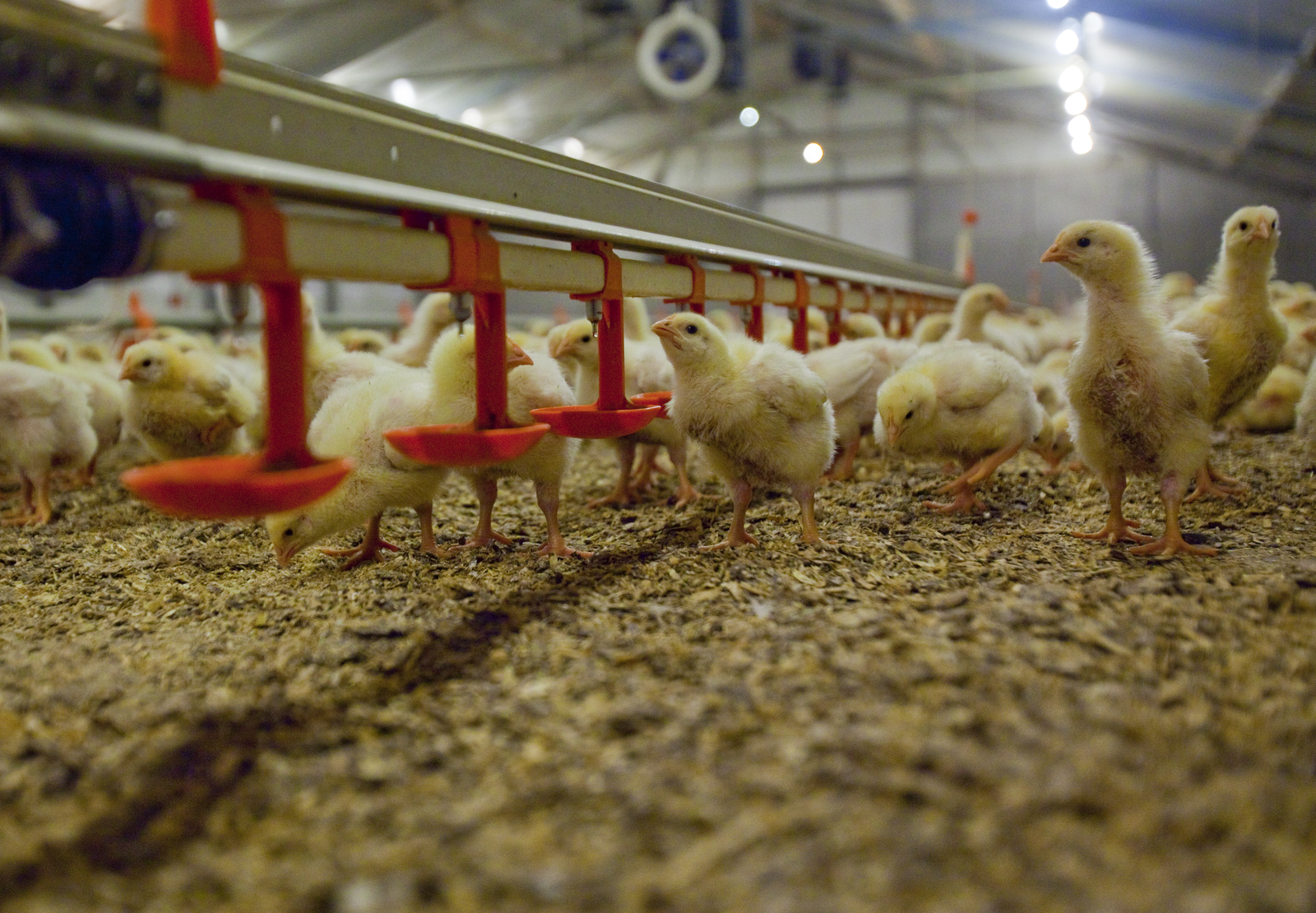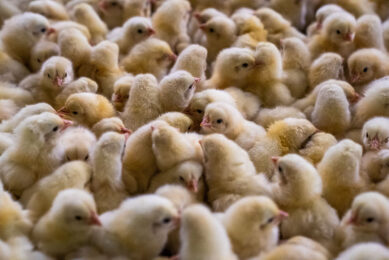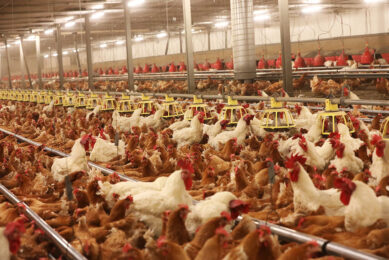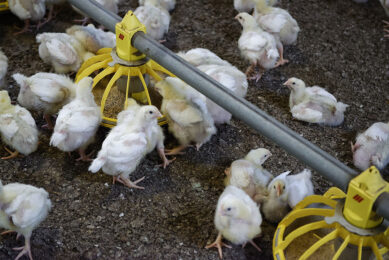Tips: Water quality deserves ongoing attention

The temperature in the broiler houses is ideal for the development and growth of micro-organisms.
Broiler farmers generally have full confidence in the drinking water they supply to their broilers. Especially when it is obtained from the water supply company. Yet this confidence often appears to be unjustified. Research in the Netherlands showed that almost 8% of water at nipple level is unsuitable and almost 20% is less suitable as drinking water for poultry.
It is important that drinking water from the water supply network or a farm well is of good quality, but it is just as important to have good-quality drinking water in the area of the drinking point (the nipple). The quality of drinking water is mainly affected by the possible presence of biofilm, a slimy layer on the inside of the water pipe. A biofilm in a water pipe is formed when micro-organisms grow on deposits of minerals and (organic) dirt particles form on the side of the pipe. Increased amounts of iron, manganese, lime and such in the water increase the chance that biofilm will form.
It can also lead to extra wear, blockages and leaks. The substances and excipients used for things such as vaccines, antibiotics, vitamins and wormers could stimulate the growth of biofilm as well. Bacteria that could be present in a biofilm include Legionella, E. coli (including the bacteria producing ECBL), Campylobacter, Pseudomonas, Salmonella, as well as Enterococci and Clostridium perfringens. In short, virtually the whole spectrum of bacteria that occur in nature can be found in the biofilm. Of all bacteria present in the drinking line, the majority (95-99%) is situated in the biofilm. When these bacteria present in the biofilm ‘break away’, they end up in the water and form a potential threat to animal health. The presence of biofilm in the water pipe can lead to reduced production, health problems, the decomposition or removal of additives, a reduced effectiveness of medication / vaccination, blockage or leakage in nipples and possibly contribute to resistance. Recent research of the GD showed that 20 weeks after administering medication in drinking water there were still residues and traces of antibiotics present.

Problems not directly connected to the source
Problems with the quality of drinking water at the nipple can arise in both water from an on-site well and water from the water supply company. But the risk of problems occurring is greater with water from a farm groundwater source. Indeed, this water can contain high concentrations of manganese, iron, nitrate and/or nitrite. Concentrations one will not find in water from a water supply company. But, as mentioned before, problems with the quality of drinking water can also arise in water obtained from a water supply company, namely problems arising in the water pipe inside the house. The temperature in the broiler houses is ideal for the development and growth of micro-organisms. Broilers are kept at temperatures between 32-36 °C. In addition, the water flow is not very good during the first few days that the broilers are indoors. Suppose there is a house with 30,000 vacancies for broilers and in this house there are 6 drinking lines (ø 30mm) 70 metres long. In this case, there are almost 300 litres of water in the drinking lines alone. Assuming a broiler consumes twice as much water as feed in the first week, the daily water intake in the first week varies from 25 ml (day one) to 70 ml (day seven). This means the daily water use of the entire house ranges between 750 litres (day one) and 2,100 litres (day seven). In other words, 2.5 – 7 times the capacity of the drinking system.

Monitoring the quality of water personally
A broiler farmer is able to monitor the water quality quite easily. It is recommended that he monitor it every regular round so he can intervene in the case of possible derogations from set standards. An appropriate moment to monitor the drinking water quality is when the broilers are between seven and 14 days old, because that is just after a critical period of high temperatures and poor flow in the drinking lines. How can a broiler farmer monitor the water quality himself?
Look and smell
Tap some water into a clean, glass jar at the beginning and at the end of the water installation. Tap some water from the faucet in the kitchen for the purpose of comparison. Shake the jars and leave them untouched for 30 minutes. Assess the colour, clarity and sediment of the jars against a white background (e.g. white paper). In addition, assess the smell of the water. Water is supposed to be clear, odourless and colourless. If the water is clear and does not smell, the likelihood of it being suitable drinking water is 85%. But if the water is turbid and smelly, something might be wrong with the quality and action should be taken. If you do not trust your own eyes and nose, take the water to an authorised laboratory for screening.
Wastewater detector
By installing a wastewater detector in the drinking line, the clarity/turbidity of the water is measured constantly through light measurement. If the sensor detects ‘polluted’ water, the drinking lines have to be rinsed out. This could be done either manually or automatically.
ATP kit
Another possibility is to check the water quality by means of an ATP kit. By using this kit, it is possible to get an idea of the (microbial and organic) pollution in the drinking water within a few minutes, instead of a few days. Please note that it is not possible to determine the kind of bacteria present in the water (E. coli, Campylobacter, Salmonella, Legionella, etc.), only to indicate the presence of bacteria. An (electronic) pH gauge is often included in the ATP kit. If this is not the case, it is recommended that you purchase one. Using litmus paper strips is also an option. In this way, it is quite feasible to monitor the quality of drinking water during the regular round.
Preventing and removing the biofilm
If it turns out that the water at the drinking points is contaminated, the polluted water pipes and the system (such as the supply tank) should be properly cleaned. Decomposing the biofilm is difficult. Drinking water pipes are not suitable to clean with a brush. That is why broiler farmers depend on detergents and flush the pipes using high (water) pressure. There are also systems that can blow pulsating air through the drinking lines. Furthermore, drinking lines can be cleaned ultrasonically. Mechanical vibrations are generated with an ultrasonic noise, which will loosen the dirt through vibration, as it were. In this way, it is possible to clean a drinking line mechanically. Of course, a combination of mechanical cleaning and detergent to remove the biofilm is also a possibility.
Once the water line is uncontaminated, it can be kept clean by adding (low doses of) disinfectants/detergents to the drinking water. Please note that the substances used for this must be allowed as additives to drinking water.
The substances may be added to the drinking water continuously or periodically (add it a few days and then stop a few days). Please bear in mind that most substances inactivate vaccines or reduce the effect of antibiotics. So, if a vaccination or a medicinal treatment is planned, the water treatment must be stopped in time and the water pipes must be flushed prior to commencing the medicinal treatment.
| Tips for good drinking water |
|---|
| Check whether your water installation has sufficient capacity (peak loads). Preferably use PVC materials. Check your installation: Is the filter situated at the front of the water pipe system? Are there any unnecessary bends? Are there any dead-end pipes? Is your supply pipe line sagging? Make the necessary adjustments. Have the drinking water checked regularly (four times a year). Have the water quality analysed both at the source and in the area of the animal (chemically and bacteriologically). Clean the filter after every regular round. Clean and disinfect the water pipe after every regular round. Make sure your dosing system works properly and you have the correct dosage (preparation solvent). Check the operation of the pressure regulator of the drinking lines on a regular basis and make sure that the water level in the corresponding piezometer tube is clearly legible. Check regularly whether the water supply to the nipples is evenly distributed in the drinking line. Flush the drinking lines frequently during the round, especially when it concerns young animals. When drinking lines are not being used the first couple of days, flush these before use. Flush the drinking lines prior to and after administering medication or vaccines. Check the smell, clarity and colour of the water yourself during your regular round. A (transparent) water filter helps identify discolouration in turbid water at an early stage. Make sure the drinking line hangs horizontally and does not sag. Make sure the drinking lines hang at the right height. Replace leaking or malfunctioning nipples immediately. Biofilm, an invisible risk of disease It is not immediately visible. It is a deposit of minerals, organic materials and bacteria, yeasts and fungi on the inside of the drinking line. It can develop extremely rapidly and contaminate the clean water during transport, which constitutes an increased disease risk for animals. It can clog the pipes, block nipples or cause leaks in nipples (leakage). It can decompose additives in the drinking water and reduce the effectiveness of vaccines and medication. Factors that affect the development of biofilm are: stagnant water, temperature, the installation and materials of water pipes, additions to the drinking water (including vaccines, additives and medication). |
Authors:
Jan van Harn, Francesca Neijenhuis and Hilko Ellen, Wageningen UR Livestock Research











